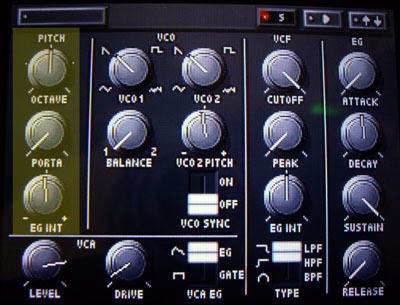
Above is what you see when you go into SYNTH EDIT for synth1 or synth2. In this post, we focus on the PITCH controls.
The OCTAVE knob enables you to shift the pitch one or two octaves up and down.
The PORTA knob controls the portamento effect which is a pitch bend from one note to the next (or one pitch value to the next). The more you turn the knob, the more time it takes the oscillators to go from note to note and therefore the smoother the transition. When turning the knob to the right, you introduce a lag which limits the speed at which oscillator signals are allowed to change and smooths out pitch changes. Depending on the instrument, it may sometimes be referred as glissando. On a synthesizer, it is usually called glide.
EG INT stands for Envelope Generator (internal as opposed to external, in other words, hard-wired). The envelope's signal can be used to modulate the pitch. If you turn the knob to the right, the pitch rises and falls according to the envelope's signal. If you turn the knob to the left, the envelope's signal is inverted, which makes the pitch falls when the signal goes up (attack) and rises when the signal goes down (decay and release). Modulation of a signal (here, the pitch) by another (here, the envelope) is a fundamental concept in analog sound synthesis.
So far, we have seen that the envelope can modulate VOLUME, FILTER and PITCH. There are other parameters that can be modulated by the envelope but those three are the most commonly found on synthesizers.
No comments:
Post a Comment